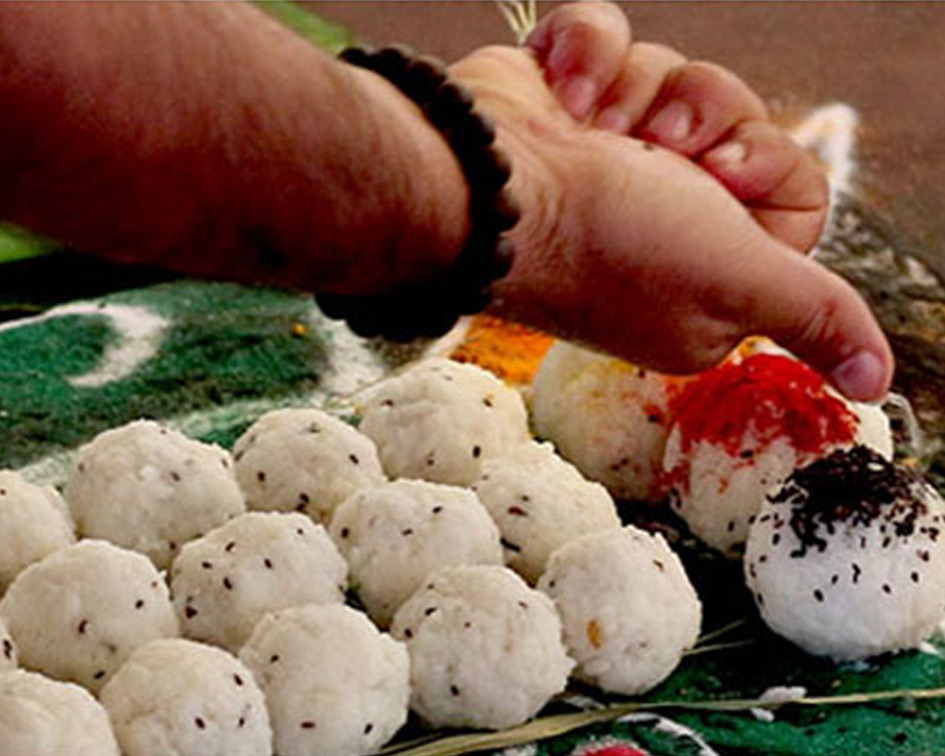
Tripindi Shraddha (Pitru Dosha)
enquiryTripindi Shradha is an offering in the memory of the dear departed. If for three consecutive years the offerings are not made to the dear departed then the dead gets vehement, so to calm them these offerings are made.
Types of afflictions:
One month of humans equals one day for the dead. The day of new moon is the lunar day for the dead. On this day Darsha Shradha is performed. Unsatisfied dead harasses in the form of demon. Cancellation of rites meant for the forefathers, denying offerings made in the memory of the dear departed and spiritual procedures if not performed as per the traditions then problems may arise from goblin, corpse, demi-gods, the 27'th lunar mansions and may led to religious discord.
Such tribulations may occur intermittently and may span in a period of one day, three days or fifteen days. It may also lead to delay in marriage prospects, failure in business, receding prosperity day after day.
Tripindi Shradha must be performed to resolve such calamities. Its assertion is mentioned in "Shradha Chintamani".
Remedy as Tripindi Shradha:
In this religious act of oblation to the dear departed, 'Yekechiprapene pindayente cha maheshwar' affirmation is mentioned. Kalidas has mentioned in his Raghuvansh MahaKavya (epic) ' Maheshwara Trambak yeva napparha'. After all maheshwar Sanghya is meant for Trimbakeshwar. 'Hey Maheshwara, (Trambak) whoever is harassing us in the form of demon destroy them all' is my prayer to you. Dead in the form of demon Ravi when it is positioned between Kanya (Virgo) and Tula (Libra) they attack on earth. This is a very important and right phase and time for offerings to the departed. By performing this Kaam Shradha (Offerings) one is liberated from the demons. Do not perform this Kaam Shradha during the festivity of Navratra. Also do not perform Tripindi Shradha and Tirtha Shradha on the same day. Perform it on different days but if you are short of time then firstly perform the Tripindi Shradha and then perform the Tirtha Shradha.
As per the above text, Tripindi Rite can be performed in Trimbakeshwar.
In this religious act of oblation to the dear departed, 'Yekechiprapene pindayente cha maheshwar' affirmation is mentioned. Kalidas has mentioned in his Raghuvansh MahaKavya (epic) ' Maheshwara Trambak yeva napparha'. After all maheshwar Sanghya is meant for Trimbakeshwar. 'Hey Maheshwara, (Trambak) whoever is harassing us in the form of demon destroy them all' is my prayer to you. Dead in the form of demon Ravi when it is positioned between Kanya (Virgo) and Tula (Libra) they attack on earth. This is a very important and right phase and time for offerings to the departed. By performing this Kaam Shradha (Offerings) one is liberated from the demons. Do not perform this Kaam Shradha during the festivity of Navratra. Also do not perform Tripindi Shradha and Tirtha Shradha on the same day. Perform it on different days but if you are short of time then firstly perform the Tripindi Shradha and then perform the Tirtha Shradha.
Performing Tripindi Shradha:
This religious act should be performed at a holy place meant for demon liberation or sacrifice. Brahma, Vishnu and Mahesh are the main Gods in this rite. Of the two kinds, from the earth, from the sky and spirit, virtue, particle, irascible also infant, young and old dead in all stages are oppressed with vehement emotions. In the end one must perform Tripindi Shradha as per the tradition and conventions. Before this rite it is necessary to undertake holy dip in Ganga for expiation and body purification. Here Skhaur is not necessary. As Shakhur is innate part of expiation, Tripindi rite is to be performed accompanied by wife. One can perform this rite even if you are single or a widower. In this God Brahma (Silver), Vishnu (Gold), Rudra (Copper) are omnipresent.
FAQ's
Tripindi shradha is a ritual for one's last right to attain salvation(Moksha).
Tripindi Shradha is performed to free the soul of the Person from worldly desires and rest in peace the departed soul.
It is performed at Trimbakeshwar by purohit
The shraddha for ancestors is performed in the month of Ashwin based on the day of their death.
The procedure(Vidhi) for performing Tripindi Shardha is firstly performing Kalash staphana, Panchang staphana, Gauri Ganesh pooja, Shodasha Matrika poojan, Navagraha poojan, Sarvotahabadhta poojan, Swasti vachan, Sankalpa, Ganesh Mahadev poojan, Abhishek, Planetary chanting, Deep pujan, Varun poojan, Shankh poojan, Tarpan ( from father's, mother's, and wife's side ), Shadopchar, Triphindhi Pooja, Pind daan, Visarjan, Donation to Brahmin, Cow feeding.
The duration for Tripindi Shardha is 3-4 hours.
Men need to wear white dhoti, and women need to wear a saree for the Pooja. The entire clothes should be new for Pooja. Black clothes should be avoided for Pooja.
When Tripindi shradha is performed at Trimbakeshwar temple Area, the departed soul attains Moksha. The daan should be given in the name of our ancestors. River Godavari represents life after death which helps the Person in attaining salvation(Moksha).
It depends very much on the samagri used by Purohit(panditji) and the daan being given by the yajamana. The easiest way to do this is the common Pooja which is also held in Trimbakeshwar.
It helps to attain decreased(dead) soul Moksha, attain peace to the family members, create new life opportunities, and gain good health and wealth.


.jpg)
.jpg)
.jpg)
.jpg)
.jpg)
.jpg)
.jpg)
.jpg)
.jpg)
.jpg)
.jpg)
.jpg)
.jpg)
.jpg)
.jpg)
.jpg)
.jpg)
.jpg)

